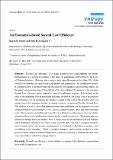An Economics-Based Second Law Efficiency
Author(s)
Mistry, Karan Hemant; Lienhard, John H.
DownloadMistry-2013-An Economics-Based S.pdf (325.0Kb)
PUBLISHER_CC
Publisher with Creative Commons License
Creative Commons Attribution
Terms of use
Metadata
Show full item recordAbstract
Second Law efficiency is a useful parameter for characterizing the energy requirements of a system in relation to the limits of performance prescribed by the Laws of Thermodynamics. However, since energy costs typically represent less than 50% of the overall cost of product for many large-scale plants (and, in particular, for desalination plants), it is useful to have a parameter that can characterize both energetic and economic effects. In this paper, an economics-based Second Law efficiency is defined by analogy to the exergetic Second Law efficiency and is applied to several desalination systems. It is defined as the ratio of the minimum cost of producing a product divided by the actual cost of production. The minimum cost of producing the product is equal to the cost of the primary source of energy times the minimum amount of energy required, as governed by the Second Law. The analogy is used to show that thermodynamic irreversibilities can be assigned costs and compared directly to non-energetic costs, such as capital expenses, labor and other operating costs. The economics-based Second Law efficiency identifies costly sources of irreversibility and places these irreversibilities in context with the overall system costs. These principles are illustrated through three case studies. First, a simple analysis of multistage flash and multiple effect distillation systems is performed using available data. Second, a complete energetic and economic model of a reverse osmosis plant is developed to show how economic costs are influenced by energetics. Third, a complete energetic and economic model of a solar powered direct contact membrane distillation system is developed to illustrate the true costs associated with so-called free energy sources.
Date issued
2013-07Department
Massachusetts Institute of Technology. Department of Mechanical EngineeringJournal
Entropy
Publisher
MDPI AG
Citation
Mistry, Karan, and John Lienhard. “An Economics-Based Second Law Efficiency.” Entropy 15, no. 7 (July 12, 2013): 2736-2765.
Version: Final published version
ISSN
1099-4300